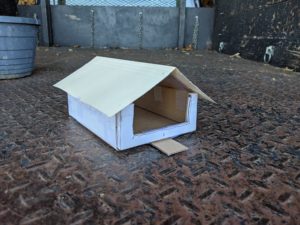A Nesting Platform for Vultures
While writing to you last week about the Coralville turkey vultures, it occurred to me that it probably would not be difficult to build a nesting platform specifically for them. The Iowa Breeding Bird Atlas, pages 102-103, addresses their needs:
“Although widely distributed across the state, nests are rarely found.”
“In recent years, vultures have tended to shift their nesting from tree cavities to abandoned buildings.”
“Although vultures nest in a variety of locations, the loss of mature trees and removal of abandoned buildings can limit nesting opportunities.”
“The species will likely continue to be an uncommon breeder in the state.”
So I consulted the book Eastern Birds’ Nests, a Peterson Field Guide, page 34, for more detailed advice. It advises habitat in “remote areas generally inaccessible to predators.” It lists unique known places like an “abandoned pigsty in woods, floor of neglected barn,” etc. It also notes that little or no nest is provided, the eggs are just laid on the ground, in gravel, wood chips, sawdust…
Several Bur Oak Land Trust properties have remote corners, which could be maintained that way by designing trails that lead hikers around rather than through.
My proposed nesting shelter design looks like a somewhat flattened doghouse with one end open:

A paper and cardboard model of proposed vulture nest box.
I think that minimum dimensions should be around 2 feet wide across the front by 3 feet deep by 18 inches high at the peak. It would be elevated, perhaps on one tall 4’ x 4” treated post, or a tree trunk cut off flat. Either would need a predator guard below. A 5’ x 5” stovepipe just fits over a 4’ x 4” post. Our violent summer storms usually roll in from the west, so face the opening to the east.
A landing board is probably desirable, allowing for a smaller shelter they can walk into, rather than flying into. Cedar wood tends to repel mites and other vermin and should be a good choice for construction, perhaps adding some cedar bedding chips on the floor. Clear brush and branches back far enough that raccoons, possums, and squirrels cannot drop or jump onto the roof from above.
Great horned owls may take over the structure, and vultures are not going to challenge the “tiger of the sky.” But the owls lay eggs in February and the young are out of the nest by sometime in April, and have no further use for a nest box, perhaps leaving it in time for vultures to take it over.
Great horned owls are one of the few predators that will deliberately kill and eat adult skunks, and they often stink. Recall from last week that skunk smell is a mercaptan, similar to dead mouse smell, and perhaps actually desirable to vultures, both because it reminds them of dinner, and because nest predators are reminded of great horned owls and the smell of death. So the vultures might prefer a recently abandoned great horned owl nest box. Maybe this is an already established practice between them?
This could be an interesting learning curve, building several different versions of the nesting platform in remote areas.
And for a very different perspective about vultures, check out my personal interview with one, see my blog from May 3, 2018: Have You Come For Me?


